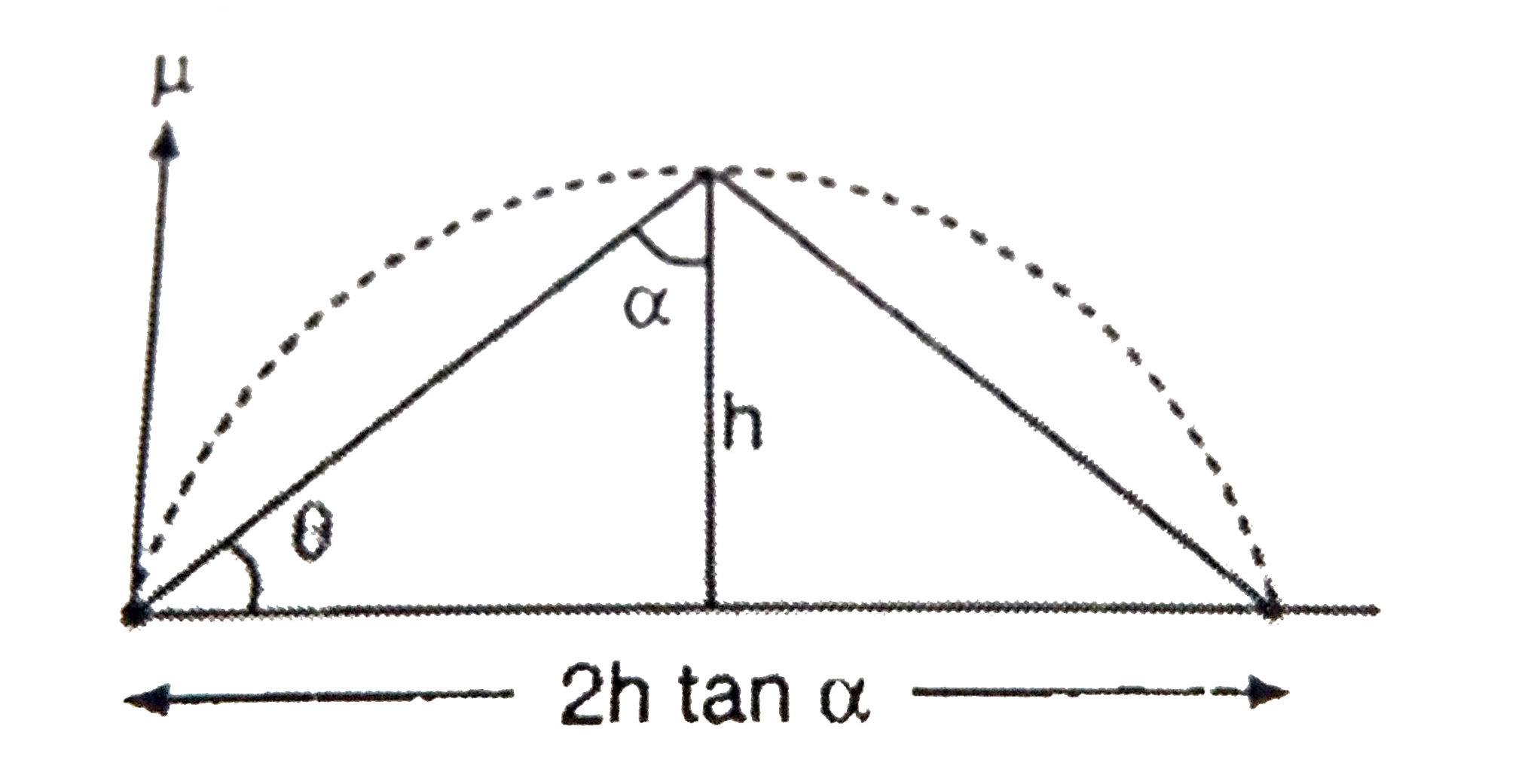A particle is projected over a traingle from one end of a horizontal base and grazing the vertex falls on the other end of the base. If α and β be the base angles and θ the angle of projection, prove that tanθ=tanα+tanβ.
To prove that tanθ=tanα+tanβ, we can follow these steps:
Step 1: Define the Triangle and Variables
Consider a triangle with base angles α and β. Let the height of the triangle be h, the distance from the point of projection to the vertex of the triangle be x, and the total horizontal distance (the range) be r. The distance from the vertex to the other end of the base will then be r−x.
Step 2: Express tanα and tanβ
Using the definition of tangent in a right triangle:
- For angle α:
tanα=hx
- For angle β:
tanβ=hr−x
Step 3: Add tanα and tanβ
Now, we can add these two expressions:
tanα+tanβ=hx+hr−x
To combine these fractions, we find a common denominator:
tanα+tanβ=h(r−x)+hxx(r−x)
This simplifies to:
tanα+tanβ=hrx(r−x)
Step 4: Relate to tanθ
Now, we need to express tanθ. The equation of the projectile motion gives us:
y=xtanθ(1−xr)
At the vertex of the triangle, the height y is equal to h. Therefore:
h=xtanθ(1−xr)
Rearranging this gives:
tanθ=hx(1−xr)
Substituting 1−xr=r−xr:
tanθ=hrx(r−x)
Step 5: Conclude the Proof
From the previous steps, we have:
tanα+tanβ=hrx(r−x)=tanθ
Thus, we have proved that:
tanθ=tanα+tanβ
Consider a triangle with base angles α and β. Let the height of the triangle be h, the distance from the point of projection to the vertex of the triangle be x, and the total horizontal distance (the range) be r. The distance from the vertex to the other end of the base will then be r−x.
Using the definition of tangent in a right triangle:
- For angle α:
tanα=hx
- For angle β:
tanβ=hr−x
Now, we can add these two expressions:
tanα+tanβ=hx+hr−x
To combine these fractions, we find a common denominator:
tanα+tanβ=h(r−x)+hxx(r−x)
This simplifies to:
tanα+tanβ=hrx(r−x)
Now, we need to express tanθ. The equation of the projectile motion gives us:
y=xtanθ(1−xr)
At the vertex of the triangle, the height y is equal to h. Therefore:
h=xtanθ(1−xr)
Rearranging this gives:
tanθ=hx(1−xr)
Substituting 1−xr=r−xr:
tanθ=hrx(r−x)
From the previous steps, we have:
tanα+tanβ=hrx(r−x)=tanθ
Thus, we have proved that:
tanθ=tanα+tanβ
Topper's Solved these Questions
- BOOK - SL ARORACHAPTER - PROJECTILE MOTIONEXERCISE - Problem For Self Practice50videos
PROJECTILE MOTION
- BOOK - SL ARORACHAPTER - PROJECTILE MOTIONEXERCISE - Problem For Self Practice50videos
PROJECTILE MOTION
- BOOK - SL ARORACHAPTER - PHYSICAL WORLD AND MEASUREMENTSEXERCISE - Based on Combination21videos
PHYSICAL WORLD AND MEASUREMENTS
- BOOK - SL ARORACHAPTER - PROPERTIES OF SOLIDSEXERCISE - All Questions97videos
PROPERTIES OF SOLIDS
Similar Questions
A particle is thrown over a triangle from one end of a horizontal base and after grazing the vertex falls on the other end of the base. If αandβ be the base angles and θ the angle of projection, prove that tanθ=tanα+tanβ .
View SolutionA particle is projected over a triangle from one extremity of its horizontal base. Grazing over the vertex, it falls on the other extremity of the base. If aandb are the base angles of the triangle and θ the angle of projection, prove that tanθ=tan∝+tanβ.
View Solution
Knowledge Check
- Question 1 - Select One
A particle is thrown over a triangle from one end of horizontal base and grazing over the vertex falls on the other end of the base. If α,β are the base angles and θ the angle of projection, then
Atanθ=tanα−tanβBtanθ=tanβ−tanαCtanθ=tanα+tanβDNone of these - Question 2 - Select One
A particle is thrown over a triangle from one end of a horizontal base and after grazing the vertex falls on the other end of the base. If 30∘and60∘ be the base angles and θ the angle of projection then tanθ is
A2√3B4√3C13D3 - Question 3 - Select One
If tanβ=cosθtanα, then tan2θ2=
Asin(α+β)sin(α−β)Bcos(α−β)cos(α+β)Csin(α−β)sin(α+β)Dcos(α+β)cos(α−β)
A particle thrown over a triangle from one end of a horizontal base falls on the other end of the base after grazing the vertex. If αandβ are the base angles of triangle and angle of projection is θ, then prove that (tanθ=tanα+tanβ)
View SolutionA projectile is fired from the base of cone shaped hill. The projectle grazes the vertex and strikes the hill again at the base. If α be the half-angle of the cone, h its height, u the initial velocity of projection and θ angle of projection, then tanθtanα is:
 View Solution
View SolutionIf 2tanβ+cotβ=tanα , prove that cotβ=2tan(α−β).
View SolutionIf αandβ are roots of the equatioin acosθ+bsinθ=c, then find the value of tan(α+β).
View SolutionIf a cos2θ+bsin2θ=c has αandβ as its solution, then the value of tanα+tanβ is
View Solution

